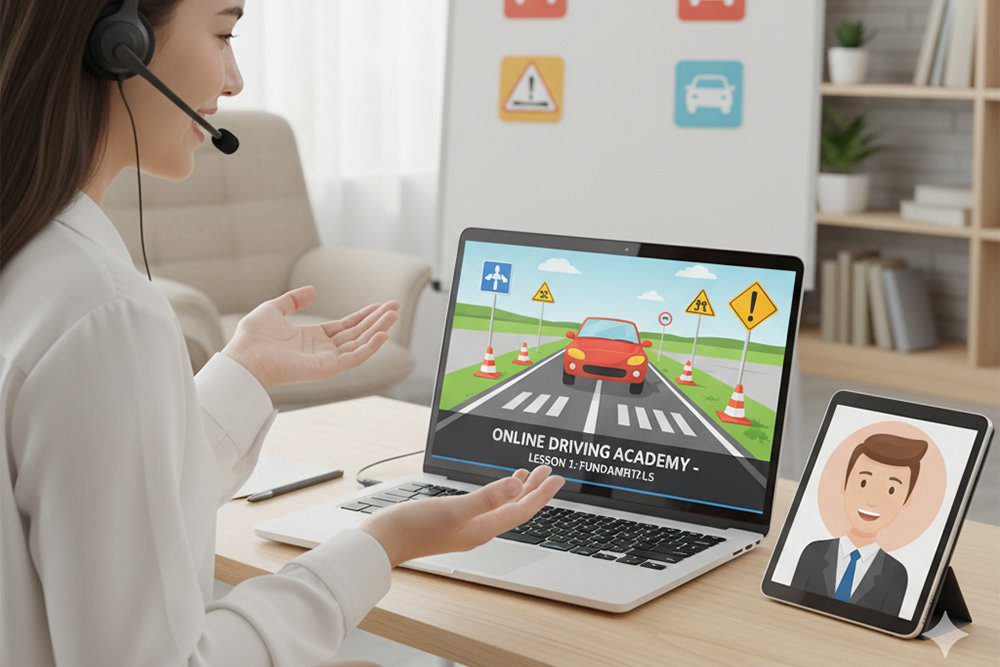In today’s fast-paced, digitally connected world, almost every aspect of life has found its way online — from training and healthcare to professional development and now, driver education in Ontario. The landscape of driver education is undergoing a major transformation, thanks to online driving lessons in Ontario programs that are redefining how new drivers learn the rules of the road.
Traditional driving schools still play a crucial role in hands-on training, but the digital shift is making learning more accessible, flexible, and personalized than ever before. Let’s explore how this digital revolution is reshaping driver education in Ontario and what it means for learners preparing for their G1 and G2 licenses.
1. The Rise of Online Driving Lessons in Ontario
The demand for online driving lessons in Ontario has surged since the COVID-19 pandemic, when in-person classes were limited or unavailable. What began as a temporary adaptation quickly became a preferred choice for many learners who wanted convenience, cost-effectiveness, and a self-paced learning environment.
These online lessons are provided by accredited virtual driving schools approved by the Ministry of Transportation (MTO). They allow students to complete the theoretical portion of their driver education from the comfort of their own home using a computer, tablet, or smartphone.
The flexibility of these programs allows learners to study at any time — whether in the evenings after school, on weekends, or even during work breaks. It’s driving education that fits into your life, not the other way around.
2. Convenience Meets Innovation: What Digital Driver Training Offers
Traditional driving education involved commuting to a classroom, attending long theory sessions, and managing schedules that often clashed with personal commitments. Digital driver training has removed these barriers, offering unmatched convenience through technology-driven learning modules.
Modern online driving courses use:
- Interactive animations to explain traffic signs and rules.
- Real-life driving simulations to visualize on-road situations.
- Gamified quizzes that help reinforce knowledge retention.
- Audio and video lessons for better engagement and understanding.
This kind of immersive experience ensures that students not only memorize rules but also understand real-world driving behavior. By merging theory with digital interactivity, digital driver training is helping students build strong cognitive foundations before they ever get behind the wheel.
3. Accessibility and Inclusivity in Driver Education
One of the biggest advantages of online driving lessons in Ontario is accessibility. These courses break down geographic and physical barriers that often prevent individuals from enrolling in traditional classes.
Students in rural or remote areas no longer need to travel long distances to find a driving school. Similarly, individuals with mobility challenges or tight work schedules can learn safely and comfortably at home.
For newcomers to Canada or students for whom English is a second language, many virtual driving schools also offer multilingual support and subtitles, ensuring everyone has equal access to learning resources.
This digital inclusivity means that driver education is no longer a privilege bound by time or location — it’s now universally accessible to anyone motivated to learn.
4. Preparing for Success: G1/G2 Online Prep
Ontario’s licensing system requires learners to pass the G1 and G2 stages before obtaining a full G license. The theoretical knowledge required for these tests is often what challenges new drivers the most.
That’s where G1/G2 online prep programs come in. These modules are specifically designed to help learners understand Ontario’s driving laws, signage, and test procedures. By practicing through mock tests and real-time quizzes, students can approach their written exams with confidence.
What makes G1/G2 online prep even more valuable is its flexibility. Learners can review tricky concepts multiple times, pause when needed, and test their understanding without feeling rushed. This personalized approach often results in higher success rates compared to traditional classroom-based instruction.
5. Cost-Effective and Efficient Learning
Online driver education doesn’t just save time — it also saves money. Traditional classroom lessons often involve transportation costs, higher tuition fees, and rigid schedules that can make rescheduling difficult. By contrast, online driving lessons Ontario programs offer lower prices while delivering equal — if not better — educational outcomes. Some schools even provide bundle packages that combine online theory with discounted in-car lessons later.
In addition, many insurance companies recognize accredited online driver education courses, which can qualify new drivers for insurance discounts once they receive their certificate of completion. In short, online driving courses offer both educational and financial benefits — a win-win for students and families.
6. The Role of Technology in Safer Driving Habits
Another crucial advantage of modern driver education lies in technology’s ability to create realistic and engaging experiences. With virtual driving school platforms, learners can experience simulated road conditions, different weather environments, and real-world challenges without risk.
For example:
- Interactive modules show how to react to sudden braking or merging lanes.
- 3D animations depict complex intersections or pedestrian crossings.
- AI-based progress tracking identifies weak areas to improve before real-world driving begins.
This simulated experience builds safer, more prepared drivers. It’s no surprise that many experts believe combining virtual learning with real-world practice produces the most well-rounded new drivers Ontario has ever seen.
7. The Blend of Online and In-Car Learning
While digital learning provides flexibility and a strong theoretical foundation, hands-on experience behind the wheel remains irreplaceable. That’s why many virtual driving schools now offer hybrid programs that combine online theory with in-person driving sessions.
This blended learning model ensures that students apply what they’ve learned digitally in real-world situations. For instance, after mastering road signs online, learners can immediately practice identifying them during in-car training. By reinforcing lessons across both mediums, students retain information longer and build confidence faster. Hybrid programs are quickly becoming the gold standard for driver education in Ontario.
8. Government Recognition and Certification
The Ontario Ministry of Transportation recognizes the growing importance of digital education. Approved online courses meet strict MTO standards and are treated equally to traditional in-class programs.
Upon completion, students receive an MTO-approved certificate that can be used for insurance discounts and driving test eligibility. This official recognition ensures that online education maintains high quality, integrity, and consistency across the province — assuring learners that their online driving lessons in Ontario are legitimate, effective, and widely accepted.
9. The Future of Driver Education in Ontario
As technology continues to evolve, the future of driver training will likely become even more digital and data-driven. Imagine:
- Virtual Reality (VR) driving simulations for real-time scenario testing.
- AI-based feedback on student performance.
- Cloud-based learning records that seamlessly integrate with driving schools.
These innovations could make digital driver training even more personalized and efficient, ensuring that future generations of Ontario drivers are safer, more informed, and more confident than ever before.
The shift toward online learning also aligns perfectly with Ontario’s sustainability goals. By reducing the need for physical classrooms and transportation, online courses contribute to a smaller carbon footprint — making digital education both smart and eco-friendly.
10. Why MB Accounting Students and Working Professionals Love It
For busy professionals, students, and parents balancing multiple responsibilities, online driving lessons in Ontario offer unmatched flexibility. Instead of rearranging work or school schedules, learners can study during breaks or evenings.
Young drivers who are already tech-savvy find digital learning intuitive, while adults returning to the road appreciate the clear, interactive format. The ability to learn independently and track progress in real-time empowers learners to take charge of their driver education journey.
Ultimately, the new era of driver education is all about choice — giving Ontarians the tools to learn in ways that suit their lifestyle and pace.
Conclusion
The transformation of driver education in Ontario through online learning is more than a temporary trend — it’s a long-term shift toward smarter, safer, and more accessible training.
From interactive simulations to G1/G2 online prep, and from personalized progress tracking to recognized certification, the advantages are undeniable. Virtual driving school platforms are not only making driver education easier to access but also ensuring higher engagement and safer outcomes on the road.
Whether you’re a new driver preparing for your first test or a busy professional upgrading your skills, online driving lessons in Ontario offer a modern, flexible, and effective path to success behind the wheel.
The future of driving education has arrived — and it’s online.
FAQ’s
Q1. Are online driving courses accepted for G2 preparation?
A: Yes. The Ontario Ministry of Transportation (MTO) approves specific online driver education programs for G2 preparation, provided they are completed through recognized and accredited providers.
Q2. Can online lessons replace in-car practice?
A: No. Online lessons are ideal for theory and knowledge building, but practical in-car sessions remain essential for mastering real-world driving skills and on-road experience.





